steering VOLKSWAGEN UP! 2021 Owner´s Manual
[x] Cancel search | Manufacturer: VOLKSWAGEN, Model Year: 2021, Model line: UP!, Model: VOLKSWAGEN UP! 2021Pages: 211, PDF Size: 5.98 MB
Page 6 of 211
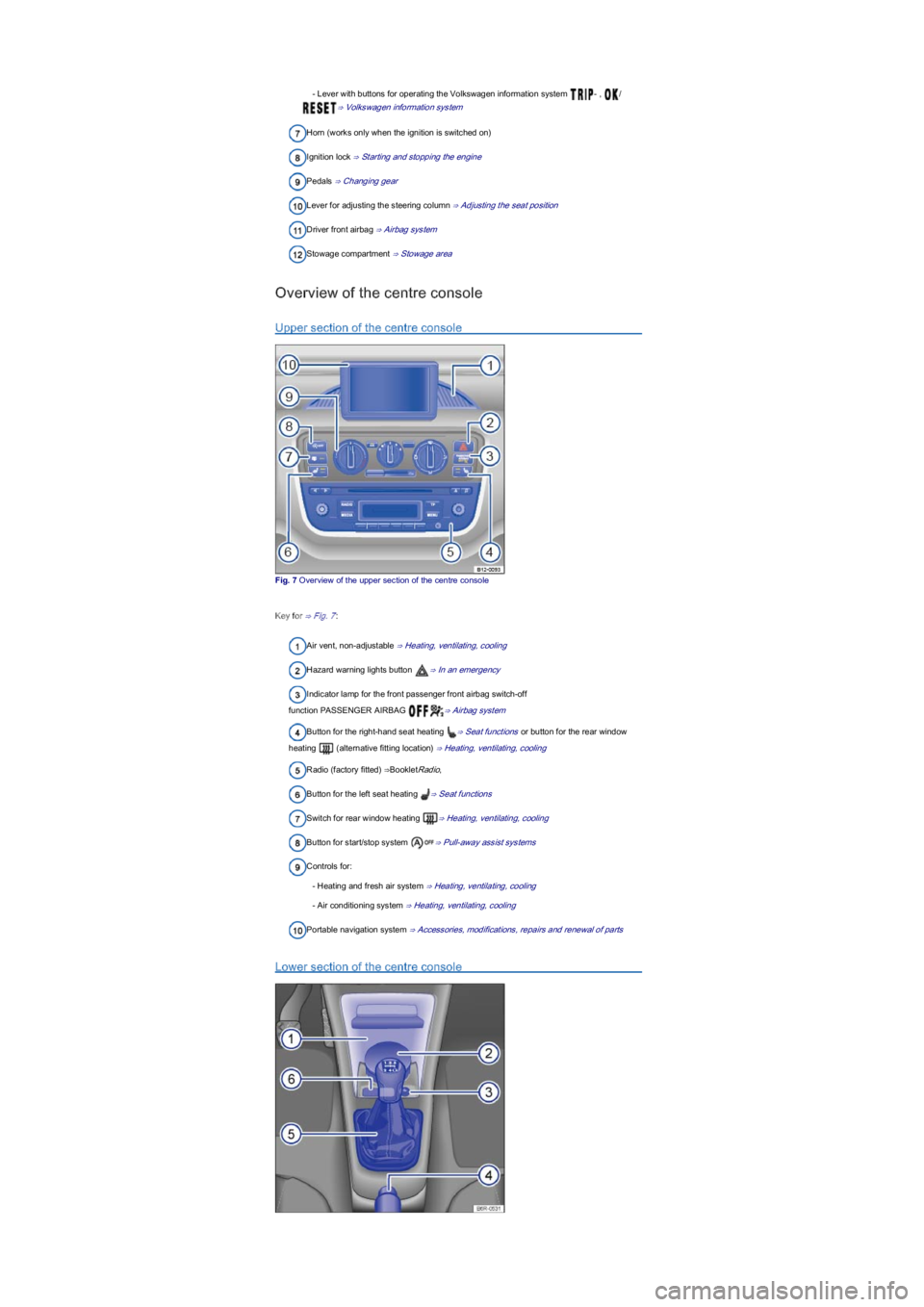
- Lever with buttons for operating the Volkswagen information system - , /
⇒ Volkswagen information system
Horn (works only when the ignition is switched on)
Ignition lock ⇒ Starting and stopping the engine
Pedals ⇒ Changing gear
Lever for adjusting the steering column ⇒ Adjusting the seat position
Driver front airbag ⇒ Airbag system
Stowage compartment ⇒ Stowage area
Overview of the centre console
Upper section of the centre console
Fig. 7 Overview of the upper section of the centre console
Key for ⇒ Fig. 7:
Air vent, non-adjustable ⇒ Heating, ventilating, cooling
Hazard warning lights button ⇒ In an emergency
Indicator lamp for the front passenger front airbag switch-off
function PASSENGER AIRBAG ⇒ Airbag system
Button for the right-hand seat heating ⇒ Seat functions or button for the rear window
heating (alternative fitting location) ⇒ Heating, ventilating, cooling
Radio (factory fitted) ⇒BookletRadio,
Button for the left seat heating ⇒ Seat functions
Switch for rear window heating ⇒ Heating, ventilating, cooling
Button for start/stop system ⇒ Pull-away assist systems
Controls for:
- Heating and fresh air system ⇒ Heating, ventilating, cooling
- Air conditioning system ⇒ Heating, ventilating, cooling
Portable navigation system ⇒ Accessories, modifications, repairs and renewal of parts
Lower section of the centre console
Page 7 of 211
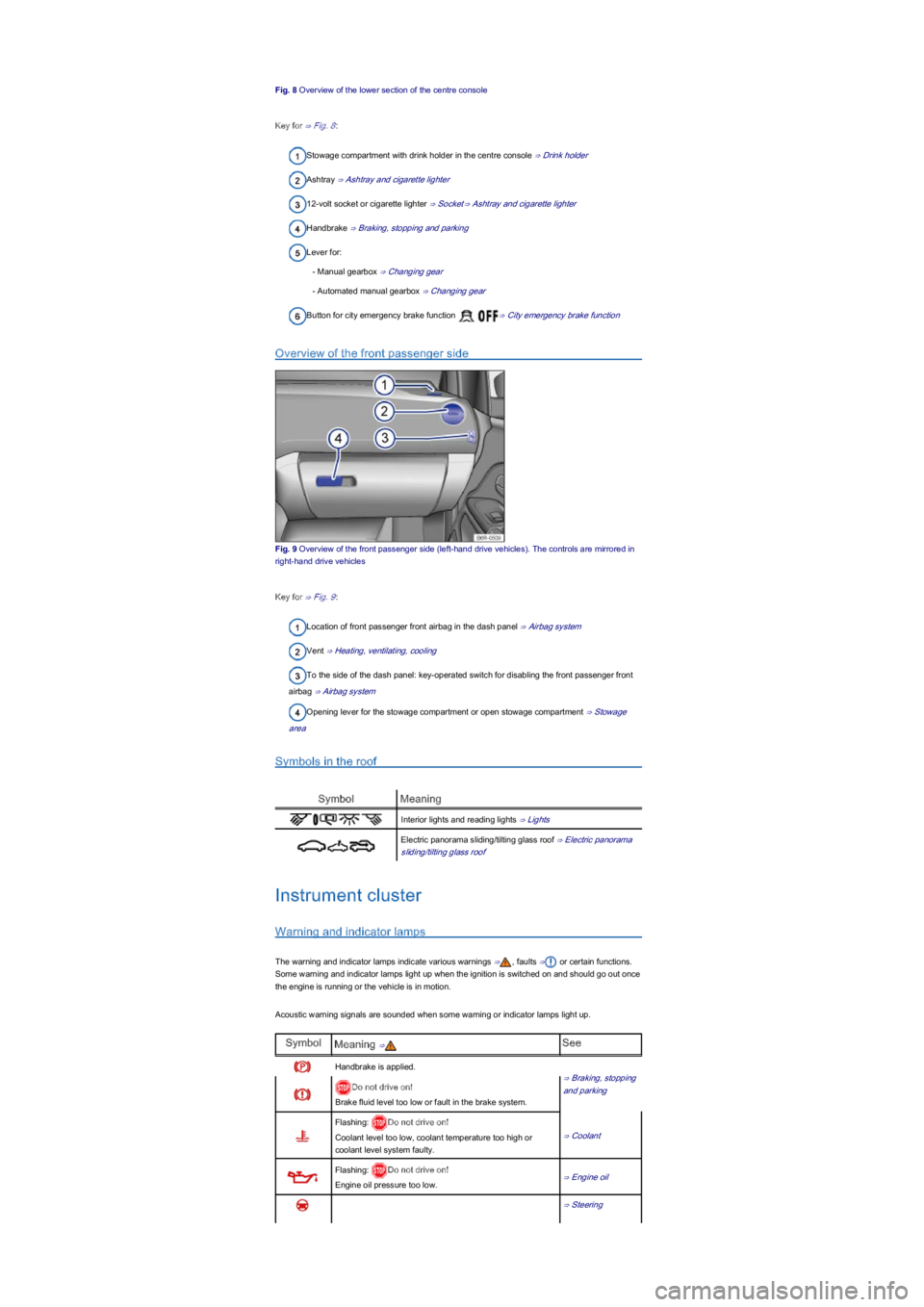
Fig. 8 Overview of the lower section of the centre console
Key for ⇒ Fig. 8:
Stowage compartment with drink holder in the centre console ⇒ Drink holder
Ashtray ⇒ Ashtray and cigarette lighter
12-volt socket or cigarette lighter ⇒ Socket⇒ Ashtray and cigarette lighter
Handbrake ⇒ Braking, stopping and parking
Lever for:
- Manual gearbox ⇒ Changing gear
- Automated manual gearbox ⇒ Changing gear
Button for city emergency brake function ⇒ City emergency brake function
Overview of the front passenger side
Fig. 9 Overview of the front passenger side (left-hand drive vehicles). The controls are mirrored in
right-hand drive vehicles
Key for ⇒ Fig. 9:
Location of front passenger front airbag in the dash panel ⇒ Airbag system
Vent ⇒ Heating, ventilating, cooling
To the side of the dash panel: key-operated switch for disabling the front passenger front
airbag ⇒ Airbag system
Opening lever for the stowage compartment or open stowage compartment ⇒ Stowage
area
Symbols in the roof
SymbolMeaning
Interior lights and reading lights ⇒ Lights
Electric panorama sliding/tilting glass roof ⇒ Electric panorama
sliding/tilting glass roof
Instrument cluster
Warning and indicator lamps
The warning and indicator lamps indicate various warnings ⇒, faults ⇒ or certain functions.
Some warning and indicator lamps light up when the ignition is switched on and should go out once
the engine is running or the vehicle is in motion.
Acoustic warning signals are sounded when some warning or indicator lamps light up.
SymbolMeaning ⇒See
Handbrake is applied.
⇒ Braking, stopping
and parkingDo not drive on!
Brake fluid level too low or fault in the brake system.
Flashing: Do not drive on!
Coolant level too low, coolant temperature too high or
coolant level system faulty.
⇒ Coolant
Flashing: Do not drive on!
Engine oil pressure too low.⇒ Engine oil
⇒ Steering
Page 8 of 211
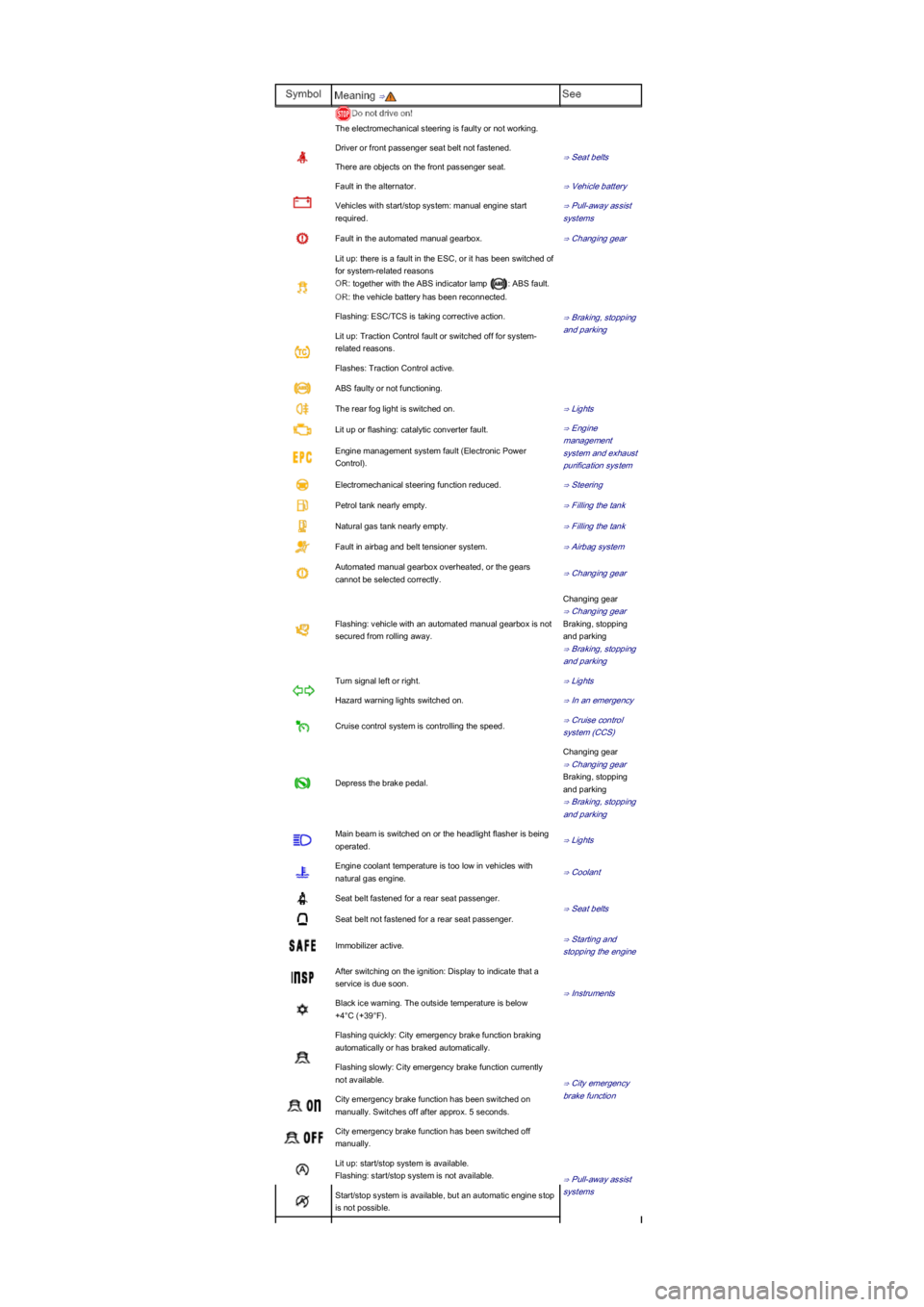
SymbolMeaning ⇒See
Do not drive on!
The electromechanical steering is faulty or not working.
Driver or front passenger seat belt not fastened.
⇒ Seat belts
There are objects on the front passenger seat.
Fault in the alternator.⇒ Vehicle battery
Vehicles with start/stop system: manual engine start
required.
⇒ Pull-away assist
systems
Fault in the automated manual gearbox.⇒ Changing gear
Lit up: there is a fault in the ESC, or it has been switched of
for system-related reasons
OR: together with the ABS indicator lamp : ABS fault.
OR: the vehicle battery has been reconnected.
⇒ Braking, stopping
and parking
Flashing: ESC/TCS is taking corrective action.
Lit up: Traction Control fault or switched off for system-
related reasons.
Flashes: Traction Control active.
ABS faulty or not functioning.
The rear fog light is switched on.⇒ Lights
Lit up or flashing: catalytic converter fault.⇒ Engine
management
system and exhaust
purification system
Engine management system fault (Electronic Power
Control).
Electromechanical steering function reduced.⇒ Steering
Petrol tank nearly empty.⇒ Filling the tank
Natural gas tank nearly empty.⇒ Filling the tank
Fault in airbag and belt tensioner system.⇒ Airbag system
Automated manual gearbox overheated, or the gears
cannot be selected correctly.⇒ Changing gear
Flashing: vehicle with an automated manual gearbox is not
secured from rolling away.
Changing gear
⇒ Changing gear
Braking, stopping
and parking
⇒ Braking, stopping
and parking
Turn signal left or right.⇒ Lights
Hazard warning lights switched on.⇒ In an emergency
Cruise control system is controlling the speed.⇒ Cruise control
system (CCS)
Depress the brake pedal.
Changing gear
⇒ Changing gear
Braking, stopping
and parking
⇒ Braking, stopping
and parking
Main beam is switched on or the headlight flasher is being
operated.⇒ Lights
Engine coolant temperature is too low in vehicles with
natural gas engine.⇒ Coolant
Seat belt fastened for a rear seat passenger.
⇒ Seat belts
Seat belt not fastened for a rear seat passenger.
Immobilizer active.⇒ Starting and
stopping the engine
After switching on the ignition: Display to indicate that a
service is due soon.
⇒ Instruments
Black ice warning. The outside temperature is below
+4°C (+39°F).
Flashing quickly: City emergency brake function braking
automatically or has braked automatically.
⇒ City emergency
brake function
Flashing slowly: City emergency brake function currently
not available.
City emergency brake function has been switched on
manually. Switches off after approx. 5 seconds.
City emergency brake function has been switched off
manually.
Lit up: start/stop system is available.
Flashing: start/stop system is not available.⇒ Pull-away assist
systemsStart/stop system is available, but an automatic engine stop
is not possible.
Page 20 of 211
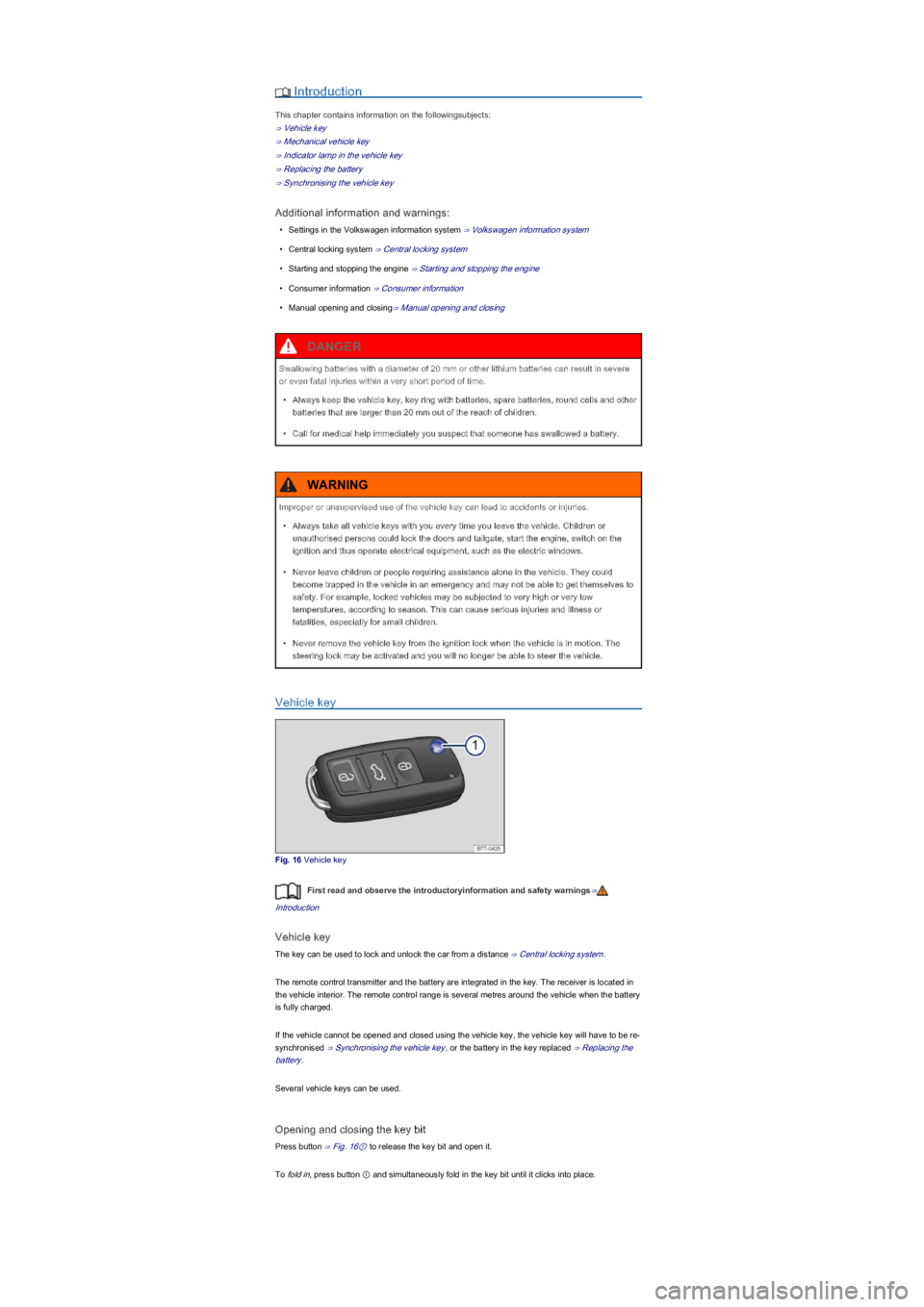
Introduction
This chapter contains information on the followingsubjects:
⇒ Vehicle key
⇒ Mechanical vehicle key
⇒ Indicator lamp in the vehicle key
⇒ Replacing the battery
⇒ Synchronising the vehicle key
Additional information and warnings:
•Settings in the Volkswagen information system ⇒ Volkswagen information system
•Central locking system ⇒ Central locking system
•Starting and stopping the engine ⇒ Starting and stopping the engine
•Consumer information ⇒ Consumer information
•Manual opening and closing⇒ Manual opening and closing
Vehicle key
Fig. 16 Vehicle key
First read and observe the introductoryinformation and safety warnings⇒
Introduction
Vehicle key
The key can be used to lock and unlock the car from a distance ⇒ Central locking system.
The remote control transmitter and the battery are integrated in the key. The receiver is located in
the vehicle interior. The remote control range is several metres around the vehicle when the battery
is fully charged.
If the vehicle cannot be opened and closed using the vehicle key, the vehicle key will have to be re-
synchronised ⇒ Synchronising the vehicle key, or the battery in the key replaced ⇒ Replacing the
battery.
Several vehicle keys can be used.
Opening and closing the key bit
Press button ⇒ Fig. 16① to release the key bit and open it.
To fold in, press button ① and simultaneously fold in the key bit until it clicks into place.
Swallowing batteries with a diameter of 20 mm or other lithium batteries can result in severe
or even fatal injuries within a very short period of time.
•Always keep the vehicle key, key ring with batteries, spare batteries, round cells and other
batteries that are larger than 20 mm out of the reach of children.
•Call for medical help immediately you suspect that someone has swallowed a battery.
DANGER
Improper or unsupervised use of the vehicle key can lead to accidents or injuries.
•Always take all vehicle keys with you every time you leave the vehicle. Children or
unauthorised persons could lock the doors and tailgate, start the engine, switch on the
ignition and thus operate electrical equipment, such as the electric windows.
•Never leave children or people requiring assistance alone in the vehicle. They could
become trapped in the vehicle in an emergency and may not be able to get themselves to
safety. For example, locked vehicles may be subjected to very high or very low
temperatures, according to season. This can cause serious injuries and illness or
fatalities, especially for small children.
•Never remove the vehicle key from the ignition lock when the vehicle is in motion. The
steering lock may be activated and you will no longer be able to steer the vehicle.
WARNING
Page 33 of 211
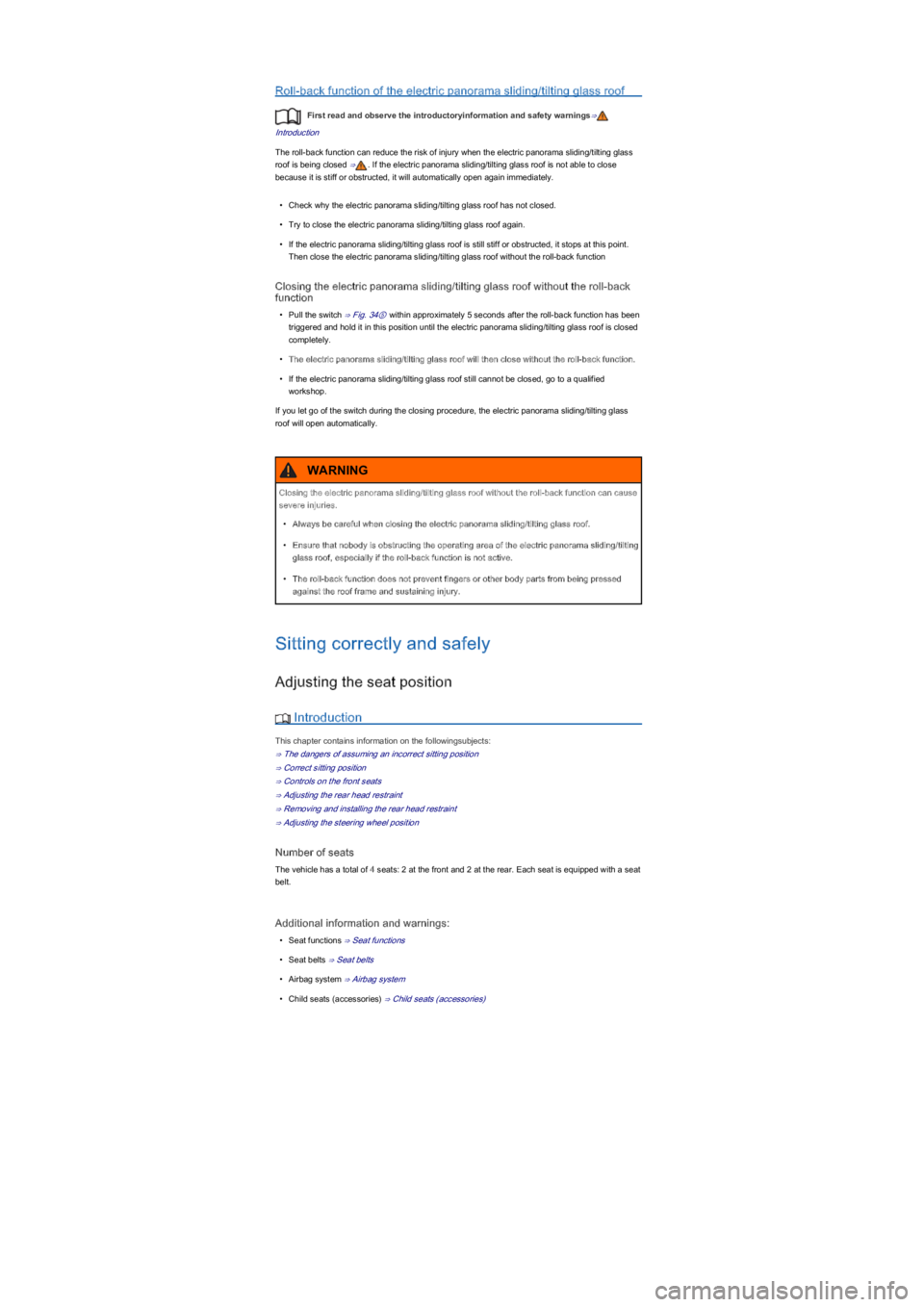
Roll-back function of the electric panorama sliding/tilting glass roof
First read and observe the introductoryinformation and safety warnings⇒
Introduction
The roll-back function can reduce the risk of injury when the electric panorama sliding/tilting glass
roof is being closed ⇒. If the electric panorama sliding/tilting glass roof is not able to close
because it is stiff or obstructed, it will automatically open again immediately.
•Check why the electric panorama sliding/tilting glass roof has not closed.
•Try to close the electric panorama sliding/tilting glass roof again.
•If the electric panorama sliding/tilting glass roof is still stiff or obstructed, it stops at this point.
Then close the electric panorama sliding/tilting glass roof without the roll-back function
Closing the electric panorama sliding/tilting glass roof without the roll-back
function
•Pull the switch ⇒ Fig. 34⑤ within approximately 5 seconds after the roll-back function has been
triggered and hold it in this position until the electric panorama sliding/tilting glass roof is closed
completely.
•The electric panorama sliding/tilting glass roof will then close without the roll-back function.
•If the electric panorama sliding/tilting glass roof still cannot be closed, go to a qualified
workshop.
If you let go of the switch during the closing procedure, the electric panorama sliding/tilting glass
roof will open automatically.
Sitting correctly and safely
Adjusting the seat position
Introduction
This chapter contains information on the followingsubjects:
⇒ The dangers of assuming an incorrect sitting position
⇒ Correct sitting position
⇒ Controls on the front seats
⇒ Adjusting the rear head restraint
⇒ Removing and installing the rear head restraint
⇒ Adjusting the steering wheel position
Number of seats
The vehicle has a total of 4 seats: 2 at the front and 2 at the rear. Each seat is equipped with a seat
belt.
Additional information and warnings:
•Seat functions ⇒ Seat functions
•Seat belts ⇒ Seat belts
•Airbag system ⇒ Airbag system
•Child seats (accessories) ⇒ Child seats (accessories)
Closing the electric panorama sliding/tilting glass roof without the roll-back function can cause
severe injuries.
•Always be careful when closing the electric panorama sliding/tilting glass roof.
•Ensure that nobody is obstructing the operating area of the electric panorama sliding/tilting
glass roof, especially if the roll-back function is not active.
•The roll-back function does not prevent fingers or other body parts from being pressed
against the roof frame and sustaining injury.
WARNING
Page 34 of 211
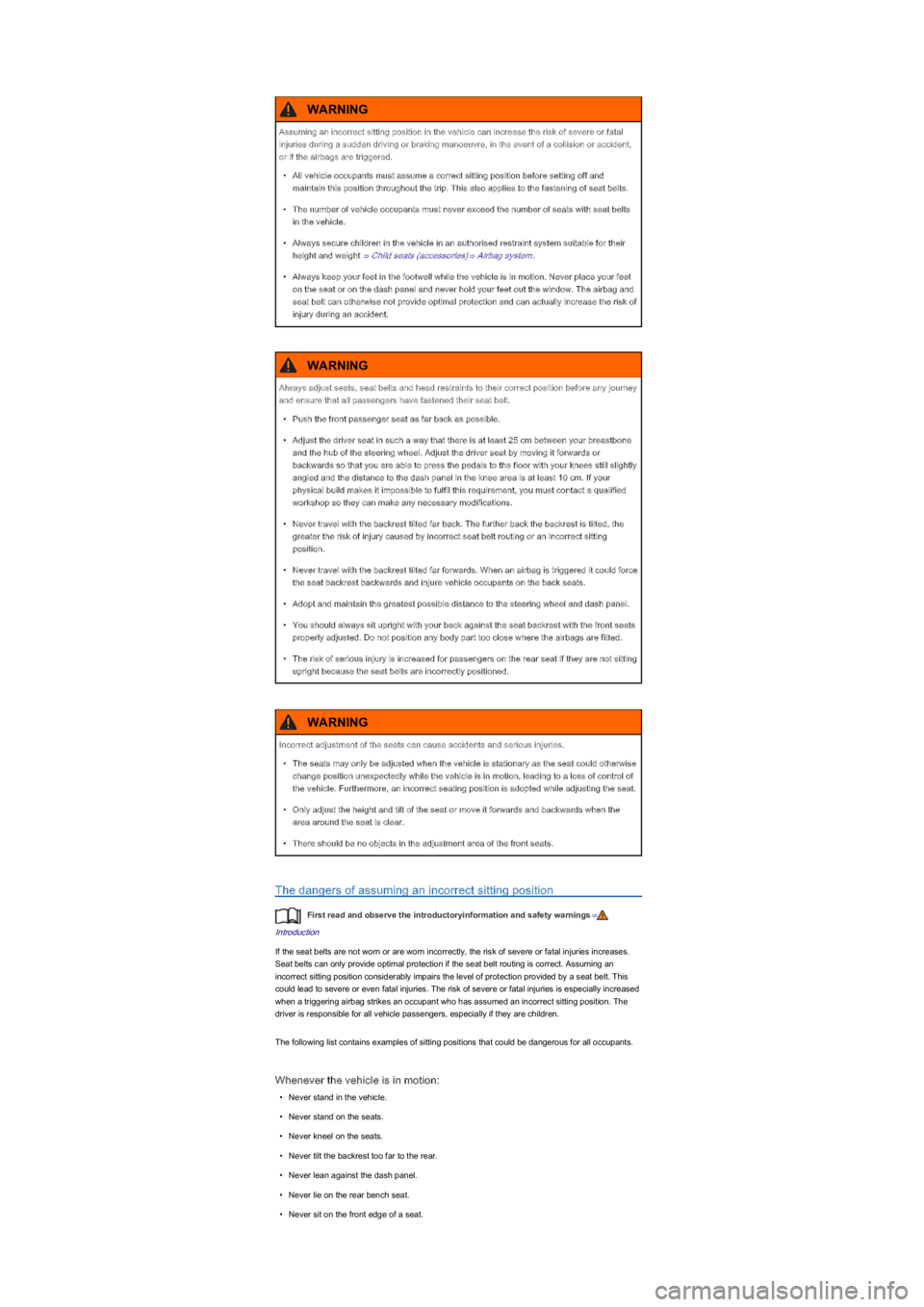
The dangers of assuming an incorrect sitting position
First read and observe the introductoryinformation and safety warnings⇒
Introduction
If the seat belts are not worn or are worn incorrectly, the risk of severe or fatal injuries increases.
Seat belts can only provide optimal protection if the seat belt routing is correct. Assuming an
incorrect sitting position considerably impairs the level of protection provided by a seat belt. This
could lead to severe or even fatal injuries. The risk of severe or fatal injuries is especially increased
when a triggering airbag strikes an occupant who has assumed an incorrect sitting position. The
driver is responsible for all vehicle passengers, especially if they are children.
The following list contains examples of sitting positions that could be dangerous for all occupants.
Whenever the vehicle is in motion:
•Never stand in the vehicle.
•Never stand on the seats.
•Never kneel on the seats.
•Never tilt the backrest too far to the rear.
•Never lean against the dash panel.
•Never lie on the rear bench seat.
•Never sit on the front edge of a seat.
Assuming an incorrect sitting position in the vehicle can increase the risk of severe or fatal
injuries during a sudden driving or braking manoeuvre, in the event of a collision or accident,
or if the airbags are triggered.
•All vehicle occupants must assume a correct sitting position before setting off and
maintain this position throughout the trip. This also applies to the fastening of seat belts.
•The number of vehicle occupants must never exceed the number of seats with seat belts
in the vehicle.
•Always secure children in the vehicle in an authorised restraint system suitable for their
height and weight ⇒ Child seats (accessories)⇒ Airbag system.
•Always keep your feet in the footwell while the vehicle is in motion. Never place your feet
on the seat or on the dash panel and never hold your feet out the window. The airbag and
seat belt can otherwise not provide optimal protection and can actually increase the risk of
injury during an accident.
WARNING
Always adjust seats, seat belts and head restraints to their correct position before any journey
and ensure that all passengers have fastened their seat belt.
•Push the front passenger seat as far back as possible.
•Adjust the driver seat in such a way that there is at least 25 cm between your breastbone
and the hub of the steering wheel. Adjust the driver seat by moving it forwards or
backwards so that you are able to press the pedals to the floor with your knees still slightly
angled and the distance to the dash panel in the knee area is at least 10 cm. If your
physical build makes it impossible to fulfil this requirement, you must contact a qualified
workshop so they can make any necessary modifications.
•Never travel with the backrest tilted far back. The further back the backrest is tilted, the
greater the risk of injury caused by incorrect seat belt routing or an incorrect sitting
position.
•Never travel with the backrest tilted far forwards. When an airbag is triggered it could force
the seat backrest backwards and injure vehicle occupants on the back seats.
•Adopt and maintain the greatest possible distance to the steering wheel and dash panel.
•You should always sit upright with your back against the seat backrest with the front seats
properly adjusted. Do not position any body part too close where the airbags are fitted.
•The risk of serious injury is increased for passengers on the rear seat if they are not sitting
upright because the seat belts are incorrectly positioned.
WARNING
Incorrect adjustment of the seats can cause accidents and serious injuries.
•The seats may only be adjusted when the vehicle is stationary as the seat could otherwise
change position unexpectedly while the vehicle is in motion, leading to a loss of control of
the vehicle. Furthermore, an incorrect seating position is adopted while adjusting the seat.
•Only adjust the height and tilt of the seat or move it forwards and backwards when the
area around the seat is clear.
•There should be no objects in the adjustment area of the front seats.
WARNING
Page 35 of 211
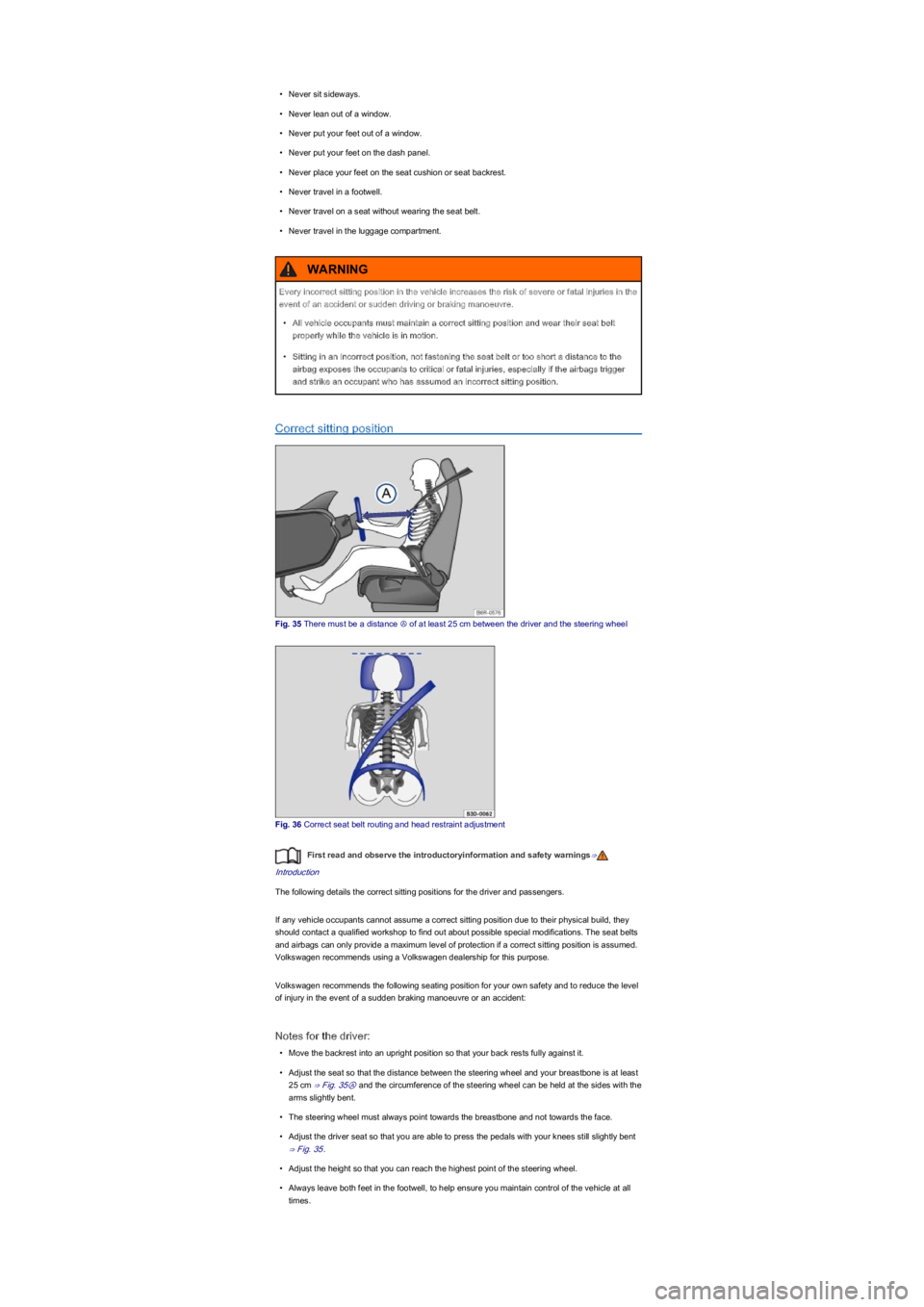
•Never sit sideways.
•Never lean out of a window.
•Never put your feet out of a window.
•Never put your feet on the dash panel.
•Never place your feet on the seat cushion or seat backrest.
•Never travel in a footwell.
•Never travel on a seat without wearing the seat belt.
•Never travel in the luggage compartment.
Correct sitting position
Fig. 35 There must be a distance Ⓐ of at least 25 cm between the driver and the steering wheel
Fig. 36 Correct seat belt routing and head restraint adjustment
First read and observe the introductoryinformation and safety warnings⇒
Introduction
The following details the correct sitting positions for the driver and passengers.
If any vehicle occupants cannot assume a correct sitting position due to their physical build, they
should contact a qualified workshop to find out about possible special modifications. The seat belts
and airbags can only provide a maximum level of protection if a correct sitting position is assumed.
Volkswagen recommends using a Volkswagen dealership for this purpose.
Volkswagen recommends the following seating position for your own safety and to reduce the level
of injury in the event of a sudden braking manoeuvre or an accident:
Notes for the driver:
•Move the backrest into an upright position so that your back rests fully against it.
•Adjust the seat so that the distance between the steering wheel and your breastbone is at least
25 cm ⇒ Fig. 35Ⓐ and the circumference of the steering wheel can be held at the sides with the
arms slightly bent.
•The steering wheel must always point towards the breastbone and not towards the face.
•Adjust the driver seat so that you are able to press the pedals with your knees still slightly bent
⇒ Fig. 35.
•Adjust the height so that you can reach the highest point of the steering wheel.
•Always leave both feet in the footwell, to help ensure you maintain control of the vehicle at all
times.
Every incorrect sitting position in the vehicle increases the risk of severe or fatal injuries in the
event of an accident or sudden driving or braking manoeuvre.
•All vehicle occupants must maintain a correct sitting position and wear their seat belt
properly while the vehicle is in motion.
•Sitting in an incorrect position, not fastening the seat belt or too short a distance to the
airbag exposes the occupants to critical or fatal injuries, especially if the airbags trigger
and strike an occupant who has assumed an incorrect sitting position.
WARNING
Page 38 of 211
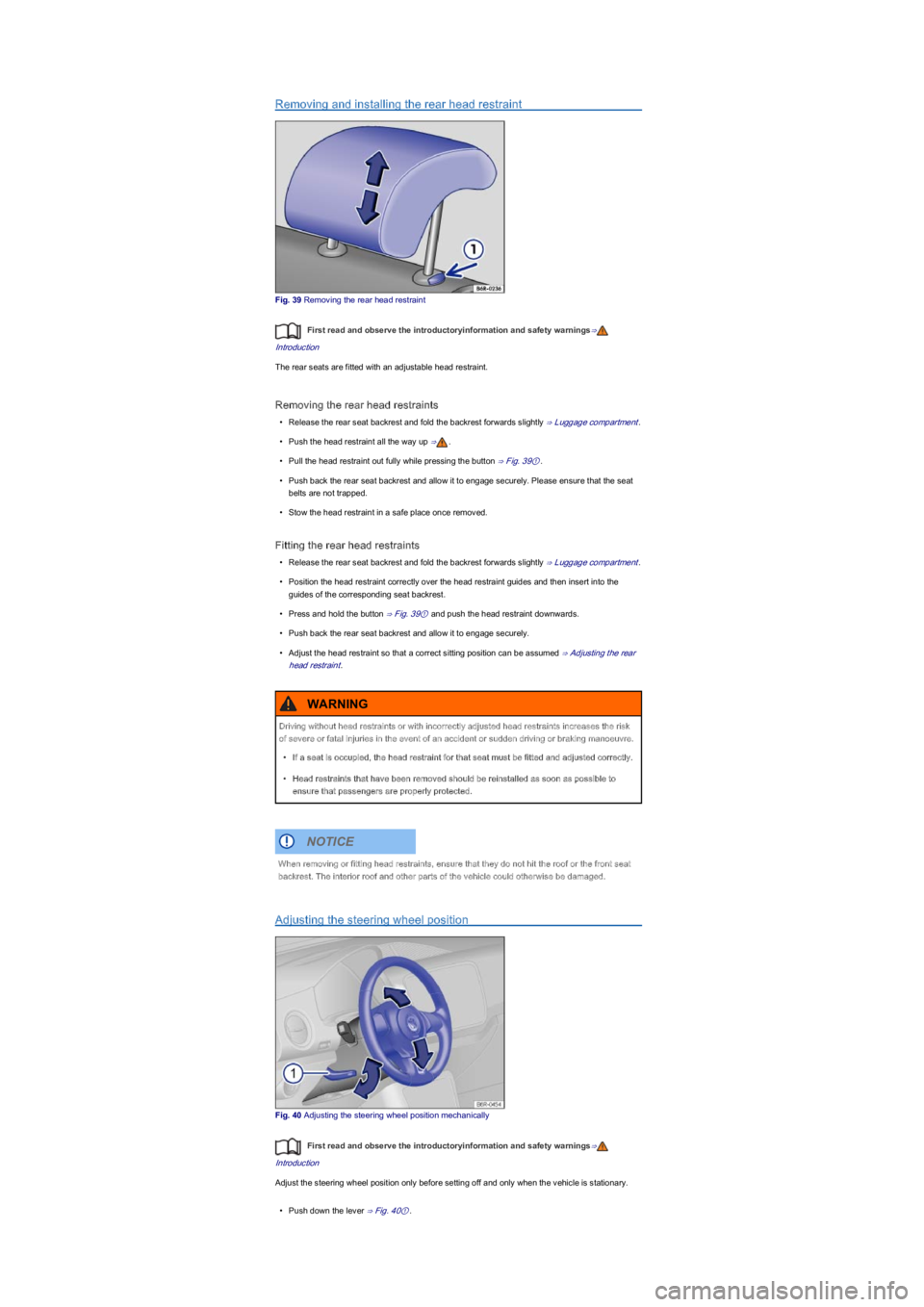
Removing and installing the rear head restraint
Fig. 39 Removing the rear head restraint
First read and observe the introductoryinformation and safety warnings⇒
Introduction
The rear seats are fitted with an adjustable head restraint.
Removing the rear head restraints
•Release the rear seat backrest and fold the backrest forwards slightly ⇒ Luggage compartment.
•Push the head restraint all the way up ⇒.
•Pull the head restraint out fully while pressing the button ⇒ Fig. 39①.
•Push back the rear seat backrest and allow it to engage securely. Please ensure that the seat
belts are not trapped.
•Stow the head restraint in a safe place once removed.
Fitting the rear head restraints
•Release the rear seat backrest and fold the backrest forwards slightly ⇒ Luggage compartment.
•Position the head restraint correctly over the head restraint guides and then insert into the
guides of the corresponding seat backrest.
•Press and hold the button ⇒ Fig. 39① and push the head restraint downwards.
•Push back the rear seat backrest and allow it to engage securely.
•Adjust the head restraint so that a correct sitting position can be assumed ⇒ Adjusting the rear
head restraint.
Adjusting the steering wheel position
Fig. 40 Adjusting the steering wheel position mechanically
First read and observe the introductoryinformation and safety warnings⇒
Introduction
Adjust the steering wheel position only before setting off and only when the vehicle is stationary.
•Push down the lever ⇒ Fig. 40①.
Driving without head restraints or with incorrectly adjusted head restraints increases the risk
of severe or fatal injuries in the event of an accident or sudden driving or braking manoeuvre.
•If a seat is occupied, the head restraint for that seat must be fitted and adjusted correctly.
•Head restraints that have been removed should be reinstalled as soon as possible to
ensure that passengers are properly protected.
WARNING
When removing or fitting head restraints, ensure that they do not hit the roof or the front seat
backrest. The interior roof and other parts of the vehicle could otherwise be damaged.
NOTICE
Page 39 of 211
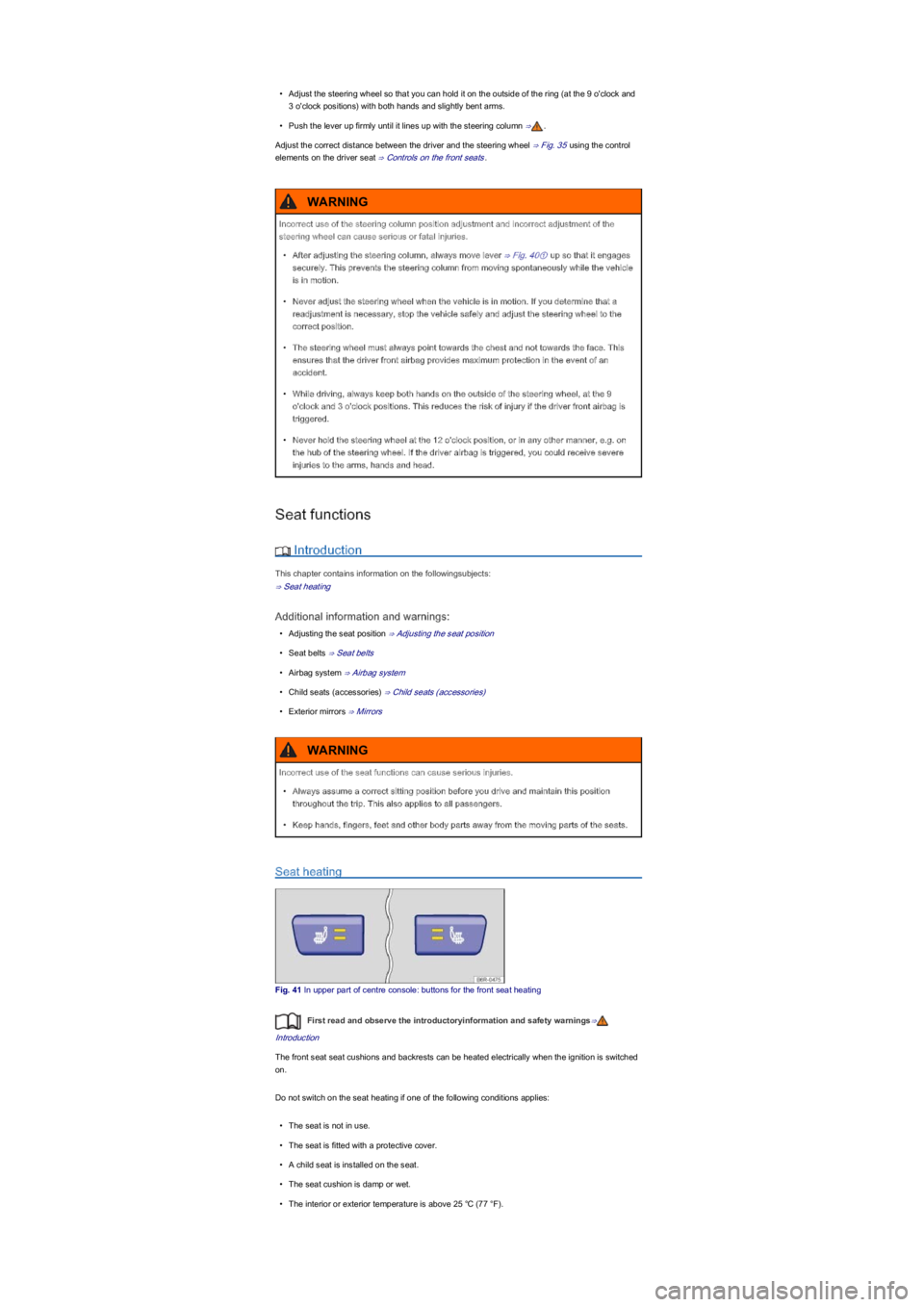
•Adjust the steering wheel so that you can hold it on the outside of the ring (at the 9 o'clock and
3 o'clock positions) with both hands and slightly bent arms.
•Push the lever up firmly until it lines up with the steering column ⇒.
Adjust the correct distance between the driver and the steering wheel ⇒ Fig. 35 using the control
elements on the driver seat ⇒ Controls on the front seats.
Seat functions
Introduction
This chapter contains information on the followingsubjects:
⇒ Seat heating
Additional information and warnings:
•Adjusting the seat position ⇒ Adjusting the seat position
•Seat belts ⇒ Seat belts
•Airbag system ⇒ Airbag system
•Child seats (accessories) ⇒ Child seats (accessories)
•Exterior mirrors ⇒ Mirrors
Seat heating
Fig. 41 In upper part of centre console: buttons for the front seat heating
First read and observe the introductoryinformation and safety warnings⇒
Introduction
The front seat seat cushions and backrests can be heated electrically when the ignition is switched
on.
Do not switch on the seat heating if one of the following conditions applies:
•The seat is not in use.
•The seat is fitted with a protective cover.
•A child seat is installed on the seat.
•The seat cushion is damp or wet.
•The interior or exterior temperature is above 25 ℃ (77 °F).
Incorrect use of the steering column position adjustment and incorrect adjustment of the
steering wheel can cause serious or fatal injuries.
•After adjusting the steering column, always move lever ⇒ Fig. 40① up so that it engages
securely. This prevents the steering column from moving spontaneously while the vehicle
is in motion.
•Never adjust the steering wheel when the vehicle is in motion. If you determine that a
readjustment is necessary, stop the vehicle safely and adjust the steering wheel to the
correct position.
•The steering wheel must always point towards the chest and not towards the face. This
ensures that the driver front airbag provides maximum protection in the event of an
accident.
•While driving, always keep both hands on the outside of the steering wheel, at the 9
o'clock and 3 o'clock positions. This reduces the risk of injury if the driver front airbag is
triggered.
•Never hold the steering wheel at the 12 o'clock position, or in any other manner, e.g. on
the hub of the steering wheel. If the driver airbag is triggered, you could receive severe
injuries to the arms, hands and head.
WARNING
Incorrect use of the seat functions can cause serious injuries.
•Always assume a correct sitting position before you drive and maintain this position
throughout the trip. This also applies to all passengers.
•Keep hands, fingers, feet and other body parts away from the moving parts of the seats.
WARNING
Page 43 of 211
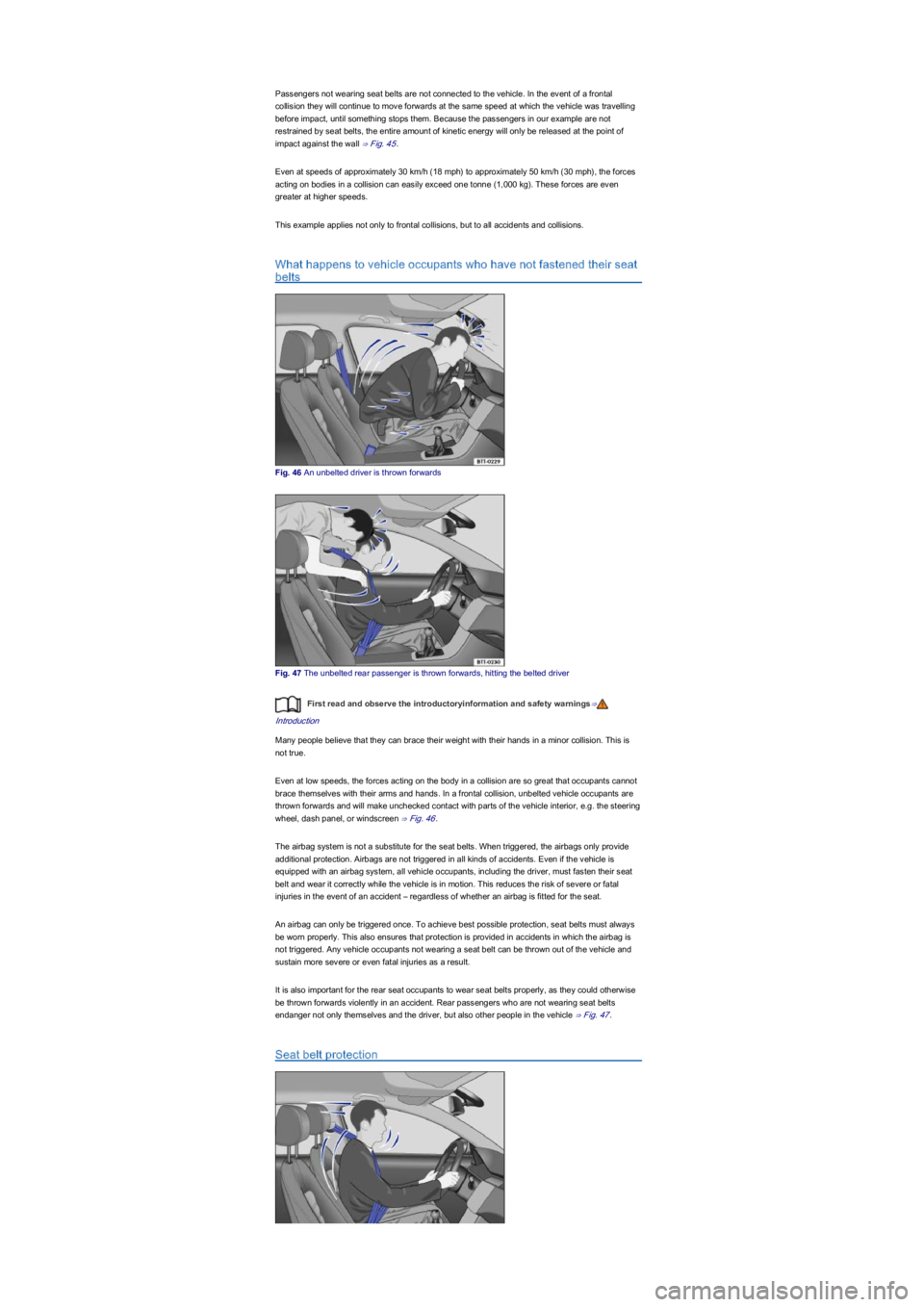
Passengers not wearing seat belts are not connected to the vehicle. In the event of a frontal
collision they will continue to move forwards at the same speed at which the vehicle was travelling
before impact, until something stops them. Because the passengers in our example are not
restrained by seat belts, the entire amount of kinetic energy will only be released at the point of
impact against the wall ⇒ Fig. 45.
Even at speeds of approximately 30 km/h (18 mph) to approximately 50 km/h (30 mph), the forces
acting on bodies in a collision can easily exceed one tonne (1,000 kg). These forces are even
greater at higher speeds.
This example applies not only to frontal collisions, but to all accidents and collisions.
What happens to vehicle occupants who have not fastened their seat
belts
Fig. 46 An unbelted driver is thrown forwards
Fig. 47 The unbelted rear passenger is thrown forwards, hitting the belted driver
First read and observe the introductoryinformation and safety warnings⇒
Introduction
Many people believe that they can brace their weight with their hands in a minor collision. This is
not true.
Even at low speeds, the forces acting on the body in a collision are so great that occupants cannot
brace themselves with their arms and hands. In a frontal collision, unbelted vehicle occupants are
thrown forwards and will make unchecked contact with parts of the vehicle interior, e.g. the steering
wheel, dash panel, or windscreen ⇒ Fig. 46.
The airbag system is not a substitute for the seat belts. When triggered, the airbags only provide
additional protection. Airbags are not triggered in all kinds of accidents. Even if the vehicle is
equipped with an airbag system, all vehicle occupants, including the driver, must fasten their seat
belt and wear it correctly while the vehicle is in motion. This reduces the risk of severe or fatal
injuries in the event of an accident – regardless of whether an airbag is fitted for the seat.
An airbag can only be triggered once. To achieve best possible protection, seat belts must always
be worn properly. This also ensures that protection is provided in accidents in which the airbag is
not triggered. Any vehicle occupants not wearing a seat belt can be thrown out of the vehicle and
sustain more severe or even fatal injuries as a result.
It is also important for the rear seat occupants to wear seat belts properly, as they could otherwise
be thrown forwards violently in an accident. Rear passengers who are not wearing seat belts
endanger not only themselves and the driver, but also other people in the vehicle ⇒ Fig. 47.
Seat belt protection